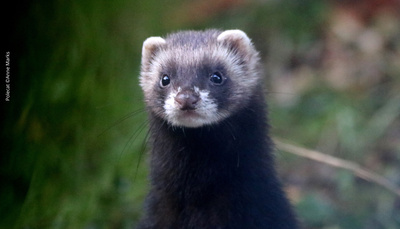Sainsbury, K. et al. (2020). Diets of European polecat Mustela putorius in Great Britain during fifty years of population recovery.


What is the National Polecat Survey?
This is the only dedicated national survey for polecats and calls on members of the public to submit any sightings of polecats. The survey will run until the end of 2025 and will be followed up by a survey report of the national findings.
The National Polecat Survey is supported by other organisations including The Mammal Society, local mammal groups and biological record centres from around Britain through the sharing of polecat data.
Anyone can get involved
No prior experience is necessary, but you will need access to a computer or smartphone to submit your sighting. If you can, please send a photograph or video of the animal to help with our verification and recording.
How to get involved
If you have seen a polecat or polecat-type animal, dead or alive, please report your sighting(s) using any one of the following methods.
VWT’s ‘Report a Sighting’ form
National Polecat Survey [Facebook page]

We are also appealing for hair and whisker samples from deceased polecats. The samples will be archived and used for future research purposes investigating polecat genetics and diet. If you have found a dead polecat and you are happy to take hair and whiskers, please consider collecting samples for science!
Instructions for how to collect samples can be found here. Once you have collected the samples, please complete an online Sample Collection Form. This form can be downloaded for printing and posting here. Samples can be posted to our address at National Polecat Survey, 3-4 Bronsil Courtyard, Eastnor, Ledbury, Herefordshire HR8 1EP.

Polecats belong to the weasel family and are ancestors of the domestic ferret. Ferrets and hybrid polecat-ferrets (an animal with a mixture of polecat and ferret characteristics) are often kept as pets or working animals, and can escape into the wild, becoming feral. Many do not survive in the wild as they don’t have the necessary skills, but some do and they can breed with wild polecats. This can produce polecat-type animals, that may be referred to as polecat-ferrets or hybrids. Distinguishing between polecats and hybrid polecat-ferrets can be difficult, but polecat-ferrets typically have more extensive pale facial markings, and can have other areas of pale fur (such as on the chest or paws).
Find out more about polecats here.

Polecats (Mustela putorius) were once a common and widespread native British carnivorous mammal that were present across England, Wales and Scotland. However, by 1915 the polecat had been eradicated from most of its former British range, remaining only in a small stronghold of mid-Wales and the English borders.
Due to a combination of factors, including legal protection under the Wildlife and Countryside Act 1981, the population is now slowly recovering and spreading across Britain. VWT monitors its recovery using National Surveys that rely on records of polecats being submitted by members of the public (also known as citizen or community scientists). This data is vital for research into this little-known species, which leaves few field signs for study by other survey methods.
What we will do with the information that is collected
The polecat sightings and records collected will be used to inform a report on polecat distribution and status in Britain. Anonymised records will also be shared with Local Ecological Record Centres and mammal recorders. No personal information will be made public or shared with other organisations.